Research
Active Galactic Nuclei
|
Active galactic nuclei (AGN) - especially the blazars - are very interesting objects for high energy astrophysics since they have many special properties: they emit electromagnetic emission over a wide energy range (from radio to gamma rays), their variability ranges from seconds to years and they are considered potential sources of high-energy protons and neutrinos. From the astronomical observations it is known that the central element of active galactic nuclei is a super massiveblack hole that serves as an engine for extremely fast plasma jets. In these plasma jets shock fronts can form in which particles are accelerated, which in turn are responsible for the wide electromagnetic radiation spectrum. My research is concerned with the question of how the spectrum of these objects can be explained. For this matter different models are used: Leptonic (z.B. Modelling the variability of 1ES1218+30.4 (Weidinger and Spanier 2010 Astronomy and Astrophysics )) and hadronic (A self-consistent and time-dependent hybrid blazar emission model. Properties and application (Weidinger and Spanier 2015 Astronomy and Astrophysics ) ) radiation models. My group has also developed spatially resolved radiation models A Numerical Model of Parsec-scale SSC Morphologies and Their Radio Emission (Richter and Spanier 2016 The Astrophysical Journal ) that allow for a morphological study of AGN. The aim of the research is to link the different observations (photons, neutrinos, possibly even protons and gravitational waves) with one another (so-called multi-messenger astronomy). In particular, the electromagnetic spectrum and its variability or even the structure of the jet should follow from the particle distribution in a self-consistent manner. |
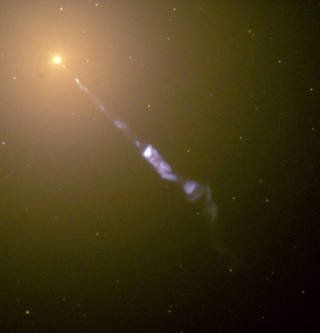
The active galactic nucleus M87 with its 10 kpc long jet. |
Kinetic plasma physics
|
Plasma describes the state of an ionized gas in which there is a collective interaction. In the literature, plasma is also referred to as the fourth state of matter - even if this represents an extreme simplification. While plasmas occur on earth (lightning, fluorescent light bulbs, coating reactors, etc.), matter in a non-ionized state ultimately dominates. The situation is different in the rest of the universe: almost everywhere, matter is in a plasma state. It is often read that 99% of all matter is in the form of plasma. The mathematical-physical description of plasmas is extremely diverse. From non-magnetized fluid plasmas to kinetic plasmas in strong magnetic fields, there are many types and descriptions of plasmas that are used in different areas. I mainly deal with the so-called kinetic plasmas - plasmas in which the distribution function of the particles is not Maxwell-Boltzmann, but an excess of particles exists at higher energies. Many astronomical objects (the sun, planets, pulsars, active galaxy nuclei etc.) accelerate particles and thus produce kinetic plasmas. Using numerical methods (e.g. Particle-in-Cell) I study how plasmas behave especially in the presence of nonthermal particle distributions. |
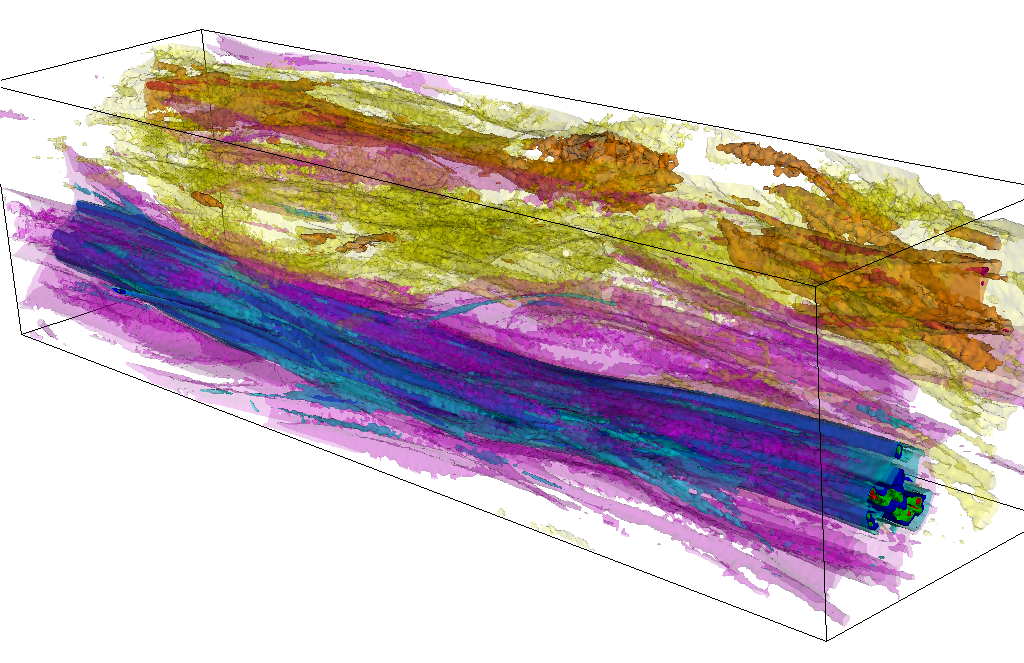
Magnetic flux tubes as they are produced by the filamentation instability. |
Turbulene
|
Turbulence is known from the everyday life of liquids and gases. Although the equations behind (hydrodynamic) turbulence are simple, the theoretical description of turbulence is still not completely clear. In plasma physics, the equations become more complicated and those in plasmas all the more complex. The areas that I deal with include the investigation of turbulence in magnetized fluid plasma (magnetohydrodynamics, cf. s. Evolution of plasma turbulence excited with particle beams (Lange and Spanier 2012 Astronomy and Astrophysics ))) and the turbulence in the area of kinetic plasmas. The questions are: how the energy is distributed, how energy is transported across scales and what anisotropies look like (or in the case of kinetic turbulence, which wave modes play a role in turbulence). As in many other project I mainly employ numerical methods like the pseudospectral MHD solber GISMO or particle-in-cell codes ACRONYM aber auch analytische Methoden Three-wave interactions of dispersive plasma waves propagating parallel to the magnetic field (Spanier and Vainio 2008 arXiv e-prints ). |
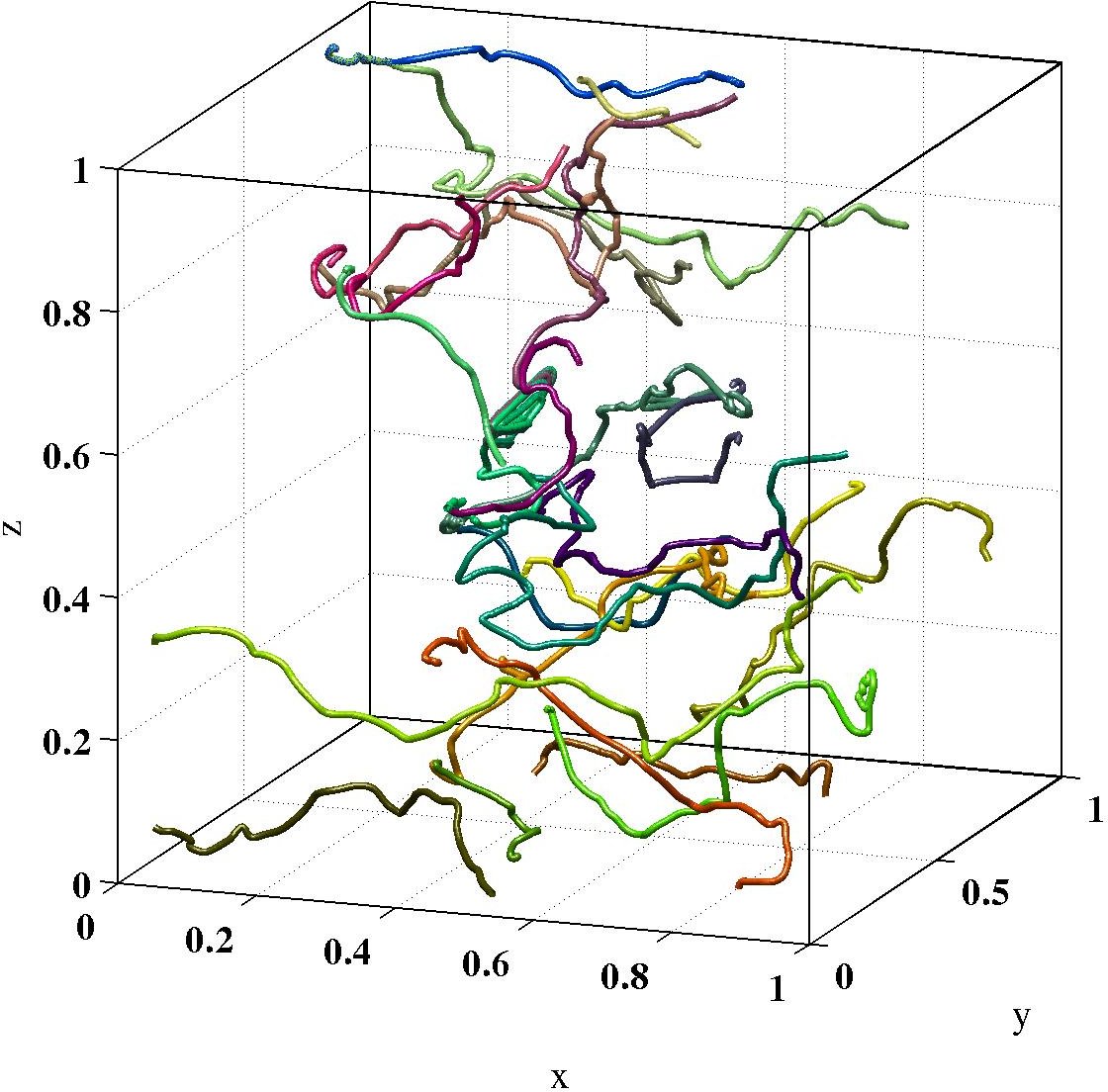
Magnetic field lines in compressible MHD turbulence |
Cosmic ray transport
|
Closely connected to turbulence research is the study of cosmic ray transport: Charged high energy particles in the heliosphere and the interstellar medium are interacting with turbulent magnetic fields. This interaction governs the transport parameters of particles. It is often assumed that the turbulent perturbations can be described as plasma waves. Already the simplest case of interaction (one particle with one wave) yields a very complicated analytical solution (Analytical treatment of particle motion in circularly polarized slab-mode wave fields (Schreiner, Vainio, and Spanier 2018 Journal of Plasma Physics )). For this reason I use again numerical models to calculate transport parameters in different turbulence realisations. The incompressible MHD code GISMO allows for the calculation of test particle tracks (Particle scattering in turbulent plasmas with amplified wave modes (Lange, Spanier et al. 2013 Astronomy and Astrophysics )). For dispersive wave modes simulations with ACRONYM an (Wave-particle-interaction in kinetic plasmas (Schreiner and Spanier 2014 Computer Physics Communications ) , Particle Scattering off of Right-Handed Dispersive Waves (Schreiner, Kilian, and Spanier 2017 The Astrophysical Journal ) ) can be performed. A major problem in analysing such test particle simulations is the derivation of transport parameters. A new method to derive quasi-linear parameters from nonlinear simulations has been developed. Determining Pitch-angle Diffusion Coefficients from Test Particle Simulations (Ivascenko, Lange, Spanier, and Vainio 2016 The Astrophysical Journal ) . |
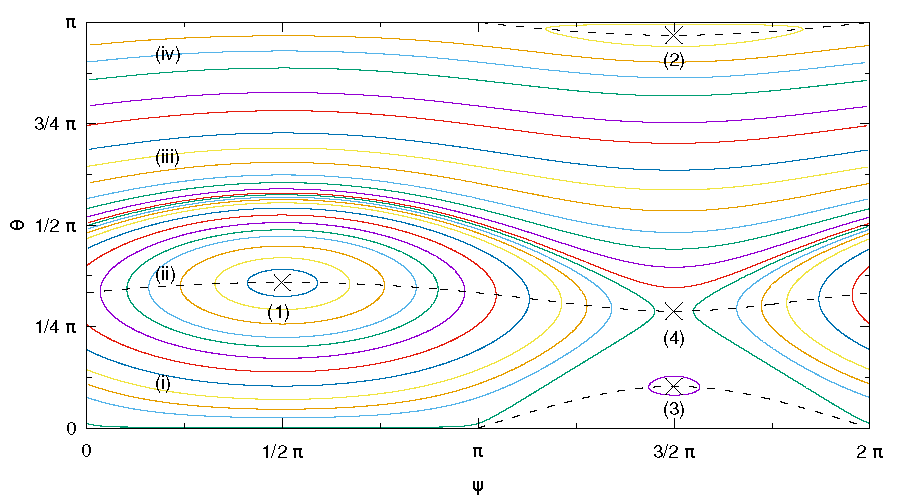
Phase space diagram for wave-particle interaction |
Shocks and particle acceleration
|
The existence of high-energy cosmic rays is known for long, as well as some of the source (e.g. the Sun, pulsars). The question how particles are accelerated to highest energies is still not solved. One of the most important mechanism is the acceleration at shock fronts. This mechanism may be close to the Sun and in the solar wind close to Mercury (Kinetic Simulations of Electron Acceleration at Mercury (Büchner, Kilian et al.} , 2018, Magnetic Fields in the Solar System ) ) In active galactic nuclei shock fronts may be assumed, but in situ observation is impossible. Only through radiation modeling (A Numerical Model of Parsec-scale SSC Morphologies and Their Radio Emission (Richter and Spanier 2016 The Astrophysical Journal ) ) is it possible to verify certain acceleration models. I study shock acceleration scenario on a microphysical level Particle-in-Cell codes aber as well as on macrophysical level through AGN modeling. This is only possible using numerical models, in which new methods are also developed. ( Simulating the injection of magnetized plasma without electromagnetic precursor wave (Kilian and Spanier 2018 Journal of Computational Physics )) |
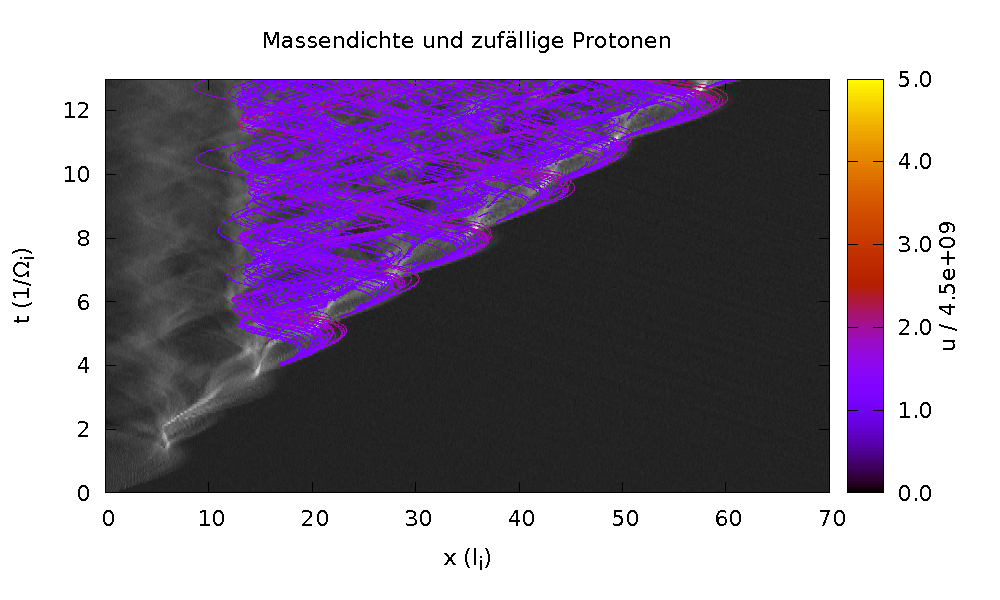
Particles tracks at a shock front. PiC-Simulation |
Plasmapyhsics in neutrino experiments
.|
The measurement of neutrino mass is not possible directly, but various experiments attempt to determine it to determine it indirectly. One way to determine it is to determine the electron spectrum from beta decays. Fermi could already show the influence of the neutrino mass on the spectrum. In the KATRIN experiment, for example, a large tritium source is used, which yields a very large number of Tritium decays. This makes it possible to measure the spectrum in detail. But there is one catch: The high-energy electrons from the beta decay ionize the tritium gas. This creates a plasma that has an electrostatic potential. This potential changes the energy difference between decay electrons and the detector. For a neutrino mass measurement with the highest possible precision, it is necessary to determine this electrostatic Potential to be determined. Dazu müssen sowohl die molekularen und atomaren Prozesse, die zur Ionisation und Rekombination führen simuliert werden als auch das Plasma selber simuliert werden. |
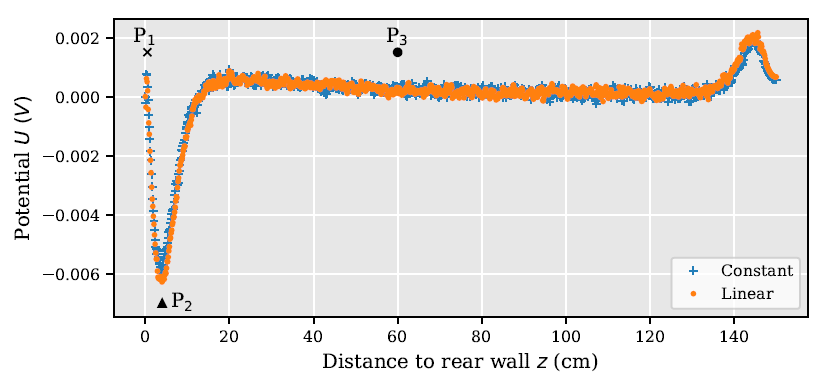
Elektrostatischs Potential in der WGTS. PiC-Simulation |

 Home page
Home page